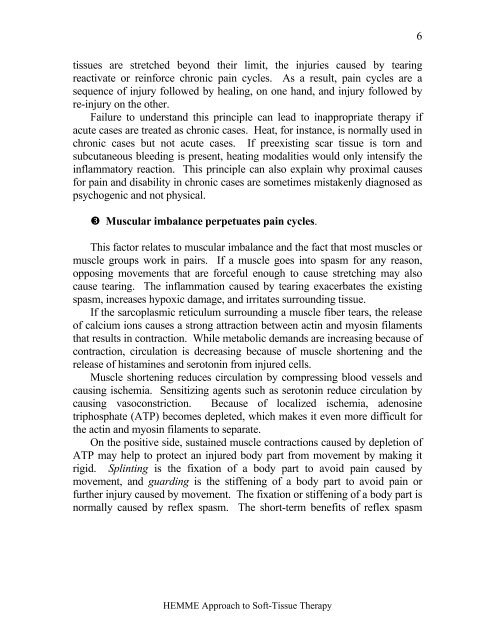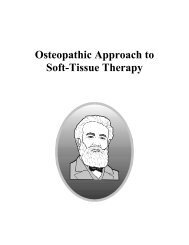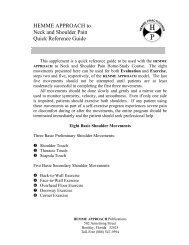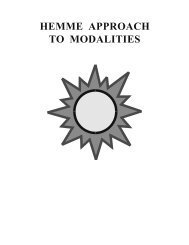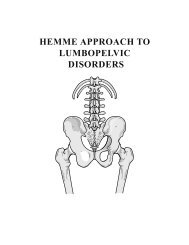HEMME APPROACH TO SOFT-TISSUE THERAPY
HEMME APPROACH TO SOFT-TISSUE THERAPY
HEMME APPROACH TO SOFT-TISSUE THERAPY
Create successful ePaper yourself
Turn your PDF publications into a flip-book with our unique Google optimized e-Paper software.
tissues are stretched beyond their limit, the injuries caused by tearing<br />
reactivate or reinforce chronic pain cycles. As a result, pain cycles are a<br />
sequence of injury followed by healing, on one hand, and injury followed by<br />
re-injury on the other.<br />
Failure to understand this principle can lead to inappropriate therapy if<br />
acute cases are treated as chronic cases. Heat, for instance, is normally used in<br />
chronic cases but not acute cases. If preexisting scar tissue is torn and<br />
subcutaneous bleeding is present, heating modalities would only intensify the<br />
inflammatory reaction. This principle can also explain why proximal causes<br />
for pain and disability in chronic cases are sometimes mistakenly diagnosed as<br />
psychogenic and not physical.<br />
Muscular imbalance perpetuates pain cycles.<br />
This factor relates to muscular imbalance and the fact that most muscles or<br />
muscle groups work in pairs. If a muscle goes into spasm for any reason,<br />
opposing movements that are forceful enough to cause stretching may also<br />
cause tearing. The inflammation caused by tearing exacerbates the existing<br />
spasm, increases hypoxic damage, and irritates surrounding tissue.<br />
If the sarcoplasmic reticulum surrounding a muscle fiber tears, the release<br />
of calcium ions causes a strong attraction between actin and myosin filaments<br />
that results in contraction. While metabolic demands are increasing because of<br />
contraction, circulation is decreasing because of muscle shortening and the<br />
release of histamines and serotonin from injured cells.<br />
Muscle shortening reduces circulation by compressing blood vessels and<br />
causing ischemia. Sensitizing agents such as serotonin reduce circulation by<br />
causing vasoconstriction. Because of localized ischemia, adenosine<br />
triphosphate (ATP) becomes depleted, which makes it even more difficult for<br />
the actin and myosin filaments to separate.<br />
On the positive side, sustained muscle contractions caused by depletion of<br />
ATP may help to protect an injured body part from movement by making it<br />
rigid. Splinting is the fixation of a body part to avoid pain caused by<br />
movement, and guarding is the stiffening of a body part to avoid pain or<br />
further injury caused by movement. The fixation or stiffening of a body part is<br />
normally caused by reflex spasm. The short-term benefits of reflex spasm<br />
6<br />
<strong>HEMME</strong> Approach to Soft-Tissue Therapy


